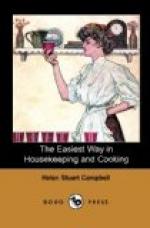Eggs come last; and as a young animal is developed from them, it follows that they contain all that is necessary for animal life, though in the case of the chicken the shell also is used, all the earthy matter being absorbed. In a hundred parts are found fourteen of nitrogen, ten and a half of fatty matter, one and a half of saline matter, and seventy-four of water. Of this water the largest part is contained in the white, which is almost pure albumen, each particle of albumen being enclosed in very thin-walled cells; it is the breaking of these cells and the admission of air that enables one to beat the white of egg to a stiff froth. The fat is accumulated in the yolk, often amounting to thirty per cent. Raw and lightly-boiled eggs are easy of digestion, but hard-boiled ones decidedly not so. An egg loses its freshness within a day or so. The shell is porous; and the always-feeding and destroying oxygen of the air quickly gains admission, causing a gradual decomposition. To preserve them, they must be coated with lard or gum, or packed in either salt or oats, points down. In this way they keep good a long time, and while hardly desirable to eat as boiled eggs, answer for many purposes in cooking.
CHAPTER XI.
THE CHEMISTRY OF VEGETABLE FOOD.
We come now to the vegetable kingdom, the principal points that we are to consider arranging themselves somewhat as follows:—
Farinaceous seeds,
Oleaginous seeds,
Leguminous seeds,
Tubers and roots,
Herbaceous articles,
Fruits,
Saccharine and farinaceous preparations.
Under the first head, that of farinaceous seeds, are included wheat, rye, oats, Indian corn, rice, and a variety of less-known grains, all possessing in greater or less degree the same constituents. It will be impossible to more than touch upon many of them; and wheat must stand as the representative, being the best-known and most widely used of all grains. Each one is made up of nitrogenous compounds, gluten, albumen, caseine, and fibrine, gluten being the most valuable. Starch, dextrine, sugar, and cellulose are also found; fatty matter, which gives the characteristic odor of grain; mineral substances, as phosphates of lime and magnesia, salts of potash and soda, and silica, which we shall shortly mention again.
Hard Wheat, or that grown in hot climates and on fertile soil, has much more nitrogen than that of colder countries. In hard wheat, in a hundred parts, twenty-two will be of nitrogen, fifty-nine starch, ten dextrine, &c, four cellulose, two and a half of fatty matter, and three of mineral, thus giving many of the constituents found in animal food.




